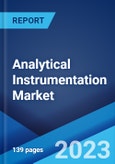The global analytical instrumentation market size reached US$ 46.1 Billion in 2022. Looking forward, the publisher expects the market to reach US$ 69.2 Billion by 2028, exhibiting a growth rate (CAGR) of 6.89% during 2023-2028.
Analytical instrumentation refers to the study of identification, separation and quantification of chemical components of natural and artificial materials. It is conducted using total organic carbon analyzers, high-performance liquid chromatography (HPLC), calorimeters and melting point analysis equipment, spectrophotometers and X-Ray diffractometers and friability testers. It aids in the analysis of materials and the determination of their composition. Besides this, as it increases the accuracy of results by eliminating errors introduced due to personal biases, analytical instrumentation is used in chemical, pharmaceutical, food-processing, and oil and gas sectors across the globe.
2. What is the expected growth rate of the global analytical instrumentation market during 2023-2028?
3. What are the key factors driving the global analytical instrumentation market?
4. What has been the impact of COVID-19 on the global analytical instrumentation market?
5. What is the breakup of the global analytical instrumentation market based on the product type?
6. What is the breakup of the global analytical instrumentation market based on the end user?
7. What are the key regions in the global analytical instrumentation market?
8. Who are the key players/companies in the global analytical instrumentation market?
Analytical instrumentation refers to the study of identification, separation and quantification of chemical components of natural and artificial materials. It is conducted using total organic carbon analyzers, high-performance liquid chromatography (HPLC), calorimeters and melting point analysis equipment, spectrophotometers and X-Ray diffractometers and friability testers. It aids in the analysis of materials and the determination of their composition. Besides this, as it increases the accuracy of results by eliminating errors introduced due to personal biases, analytical instrumentation is used in chemical, pharmaceutical, food-processing, and oil and gas sectors across the globe.
Analytical Instrumentation Market Trends:
At present, there is a rise in the utilization of analytical instruments in manufacturing electric vehicles, mobile phones, and energy systems to enhance storage potential and output and create a more efficient, cleaner, and safer energy source. This, along with the growing application of electron microscopy technologies to see structures at levels down to the atomic scale, represents one of the key factors driving the market. Moreover, the escalating demand for pharmaceutical biosimilars, phytopharmaceuticals, and regenerative medicines around the world, is propelling the growth of the market. In addition, governments of several countries are undertaking initiatives for pollution control and environmental testing, which, in turn, is offering lucrative growth opportunities to the end-users. Besides this, the rising employment of analytical instruments in shale gas production across the globe is positively influencing the market. Additionally, the increasing utilization of gas chromatography in food safety testing, quantitative screening of environmental samples, and complex molecular analysis is catalyzing the demand for analytical instrumentation worldwide. Furthermore, key market players are focusing on mergers and acquisitions (M&A), which is projected to increase their overall sales and profitability.Key Market Segmentation:
The publisher provides an analysis of the key trends in each sub-segment of the global analytical instrumentation market report, along with forecasts at the global, regional and country level from 2023-2028. The report has categorized the market based on product type and end user.Breakup by Product Type:
- Chromatography
- Molecular Analysis Spectroscopy
- Elemental Analysis Spectroscopy
- Mass Spectroscopy
- Analytical Microscopes
- Others
Breakup by End User:
- Life Sciences
- Chemical and Petrochemical
- Material Sciences
- Food Testing
- Oil and Gas
- Water and Wastewater
- Others
Breakup by Region:
- North America
- United States
- Canada
- Asia-Pacific
- China
- Japan
- India
- South Korea
- Australia
- Indonesia
- Others
- Europe
- Germany
- France
- United Kingdom
- Italy
- Spain
- Russia
- Others
- Latin America
- Brazil
- Mexico
- Others
- Middle East and Africa
Competitive Landscape:
The competitive landscape of the industry has also been examined along with the profiles of the key players being Agilent Technologies Inc., Bio-Rad Laboratories Inc., Bruker Corporation, Mettler Toledo, PerkinElmer Inc., Shimadzu Corporation, Spectris plc, Thermo Fisher Scientific Inc. and Waters Corporation.Key Questions Answered in This Report
1. How big is the global analytical instrumentation market?2. What is the expected growth rate of the global analytical instrumentation market during 2023-2028?
3. What are the key factors driving the global analytical instrumentation market?
4. What has been the impact of COVID-19 on the global analytical instrumentation market?
5. What is the breakup of the global analytical instrumentation market based on the product type?
6. What is the breakup of the global analytical instrumentation market based on the end user?
7. What are the key regions in the global analytical instrumentation market?
8. Who are the key players/companies in the global analytical instrumentation market?
Table of Contents
1 Preface3 Executive Summary10 Value Chain Analysis12 Price Analysis
2 Scope and Methodology
4 Introduction
5 Global Analytical Instrumentation Market
6 Market Breakup by Product Type
7 Market Breakup by End User
8 Market Breakup by Region
9 SWOT Analysis
11 Porters Five Forces Analysis
13 Competitive Landscape
Companies Mentioned
- Agilent Technologies Inc.
- Bio-Rad Laboratories Inc.
- Bruker Corporation
- Mettler Toledo
- PerkinElmer Inc.
- Shimadzu Corporation
- Spectris plc
- Thermo Fisher Scientific Inc.
- Waters Corporation.
Methodology

LOADING...
Table Information
| Report Attribute | Details |
|---|---|
| No. of Pages | 139 |
| Published | September 2023 |
| Forecast Period | 2022 - 2028 |
| Estimated Market Value ( USD | $ 46.1 Billion |
| Forecasted Market Value ( USD | $ 69.2 Billion |
| Compound Annual Growth Rate | 7.0% |
| Regions Covered | Global |
| No. of Companies Mentioned | 9 |









